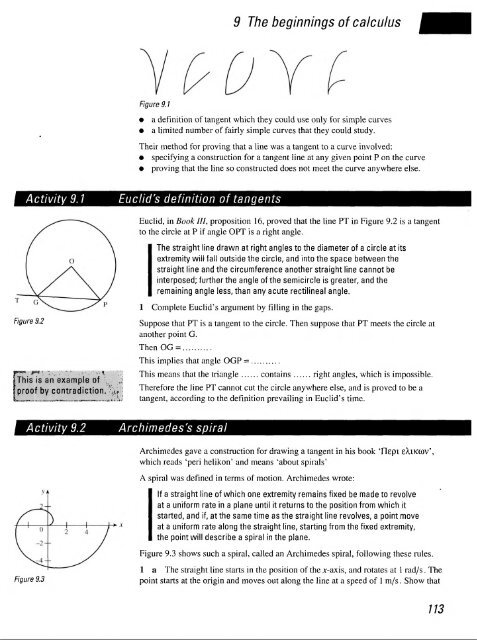history of mathematics - National STEM Centre
history of mathematics - National STEM Centre
history of mathematics - National STEM Centre
You also want an ePaper? Increase the reach of your titles
YUMPU automatically turns print PDFs into web optimized ePapers that Google loves.
Activity 9.1<br />
Figure 9.2<br />
This is an example <strong>of</strong><br />
fipro<strong>of</strong> by contradiction.<br />
Figure 9.1<br />
9 The beginnings <strong>of</strong> calculus<br />
• a definition <strong>of</strong> tangent which they could use only for simple curves<br />
• a limited number <strong>of</strong> fairly simple curves that they could study.<br />
Their method for proving that a line was a tangent to a curve involved:<br />
• specifying a construction for a tangent line at any given point P on the curve<br />
• proving that the line so constructed does not meet the curve anywhere else.<br />
Euclid's definition <strong>of</strong> tangents<br />
Euclid, in Book III, proposition 16, proved that the line PT in Figure 9.2 is a tangent<br />
to the circle at P if angle OPT is a right angle.<br />
The straight line drawn at right angles to the diameter <strong>of</strong> a circle at its<br />
extremity will fall outside the circle, and into the space between the<br />
straight line and the circumference another straight line cannot be<br />
interposed; further the angle <strong>of</strong> the semicircle is greater, and the<br />
remaining angle less, than any acute rectilineal angle.<br />
1 Complete Euclid's argument by filling in the gaps.<br />
Suppose that PT is a tangent to the circle. Then suppose that PT meets the circle at<br />
another point G.<br />
ThenOG = ..........<br />
This implies that angle OGP = ..........<br />
Activity 9.2 Archimedes's spiral<br />
Figure 9.3<br />
This means that the triangle ...... contains ...... right angles, which is impossible.<br />
Therefore the line PT cannot cut the circle anywhere else, and is proved to be a<br />
tangent, according to the definition prevailing in Euclid's time.<br />
Archimedes gave a construction for drawing a tangent in his book Tlept e?UK(ov',<br />
which reads 'peri helikon' and means 'about spirals'<br />
A spiral was defined in terms <strong>of</strong> motion. Archimedes wrote:<br />
If a straight line <strong>of</strong> which one extremity remains fixed be made to revolve<br />
at a uniform rate in a plane until it returns to the position from which it<br />
started, and if, at the same time as the straight line revolves, a point move<br />
at a uniform rate along the straight line, starting from the fixed extremity,<br />
the point will describe a spiral in the plane.<br />
Figure 9.3 shows such a spiral, called an Archimedes spiral, following these rules.<br />
1 a The straight line starts in the position <strong>of</strong> the jc-axis, and rotates at 1 rad/s. The<br />
point starts at the origin and moves out along the line at a speed <strong>of</strong> 1 m/s. Show that<br />
773
















